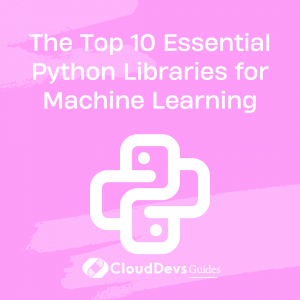The Top 10 Essential Python Libraries for Machine Learning
As the landscape of machine learning (ML) continues to evolve, developers and data scientists find themselves in an ongoing search for the most efficient tools to transform their ideas into working models. Python has become the go-to language for machine learning due to its simplicity, readability, and the breadth of its scientific libraries. This proficiency is crucial whether you’re a developer or looking to hire Python developers. In this article, we delve into the top 10 Python libraries that have played a key role in shaping machine learning, offering a broad range of functionalities from data manipulation to advanced deep learning capabilities. This knowledge is essential for those aiming to hire Python developers for cutting-edge ML projects.
1. NumPy
NumPy, which stands for Numerical Python, is the foundational package for scientific computing in Python. It provides support for arrays and matrices, along with a vast collection of mathematical functions to operate on these data structures. NumPy is critical to machine learning as many other libraries (like TensorFlow and PyTorch) are built on top of it. It ensures computational efficiency with its powerful N-dimensional array object, which is essential for handling large datasets, a typical requirement in ML applications.
2. Pandas
When it comes to data manipulation and analysis, Pandas is a go-to library for Python users. It provides essential data structures like Series and DataFrame and tools for data wrangling tasks, which involve cleaning, filtering, and merging datasets, among other operations. Pandas is essential for preprocessing data – a crucial step in any machine learning workflow.
3. Matplotlib
Visualizing data is a key step in the machine learning pipeline, and Matplotlib is a popular Python library for this purpose. It offers a flexible platform to create a wide range of static, animated, and interactive plots in a few lines of code. By allowing us to visualize data and ML model performance, Matplotlib plays an important role in understanding and interpreting machine learning models.
4. Scikit-learn
Scikit-learn is arguably one of the most practical libraries in Python for machine learning. It provides a wide array of algorithms for supervised and unsupervised learning, including regression, classification, clustering, and dimensionality reduction. Additionally, it includes tools for model selection, evaluation, and preprocessing, making it a comprehensive library ideal for both beginners and seasoned practitioners.
5. SciPy
SciPy is a Python library used for scientific and technical computing. It extends the functionality of NumPy and provides many user-friendly interfaces for tasks such as numerical integration, optimization, statistics, and signal processing. These features are particularly useful in machine learning, where optimization problems are common.
6. TensorFlow
Developed by Google, TensorFlow has become one of the leading libraries for building and training deep learning models. It provides a comprehensive and flexible platform for machine learning and artificial intelligence projects. TensorFlow’s ability to perform numerical computations using data flow graphs and its scalable nature make it suitable for implementing complex ML models, including neural networks.
7. Keras
Keras is a high-level neural networks API, written in Python and capable of running on top of TensorFlow, CNTK, or Theano. It was developed with a focus on enabling fast experimentation. With its user-friendly and modular architecture, Keras makes building and prototyping deep learning models easy and efficient. It is a great tool, especially for beginners trying to understand the fundamentals of neural networks.
8. PyTorch
PyTorch, backed by Facebook’s AI Research lab, is another significant player in the world of machine learning. Its main feature is an n-dimensional Tensor, similar to NumPy but with GPU acceleration. PyTorch has a dynamic computational graph, providing flexibility and speed in building and modifying models, making it very suitable for deep learning research.
9. LightGBM
LightGBM is a gradient boosting framework that uses tree-based learning algorithms. It is designed to be fast and efficient, even on large datasets. LightGBM is unique in its use of a histogram-based algorithm which buckets continuous feature values into discrete bins, accelerating training speed and reducing memory usage. It performs exceptionally well on structured or tabular data, making it a favorite tool in machine learning competitions.
10. XGBoost
XGBoost stands for eXtreme Gradient Boosting. It’s an optimized distributed gradient boosting library designed to be highly efficient, flexible, and portable. XGBoost provides a parallel tree boosting algorithm, the key to its speed and efficiency. It is renowned for its performance and computational speed, often serving as the go-to algorithm for machine learning competitions and complex industrial problems.
Conclusion
This list is just a fraction of the many Python libraries available for machine learning. Each library has its strengths and is suited to different kinds of tasks and problems. The best way to determine which one is right for your project is to understand your requirements and the characteristics of your data thoroughly.
While knowing these libraries is undoubtedly beneficial, successful machine learning projects also rely heavily on understanding the underlying principles and algorithms, a good grasp of the problem domain, and the capability to preprocess and interpret data correctly. These skill sets are essential when you’re looking to hire Python developers for your projects.
Remember that the tools are only as good as the craft person’s ability to use them. So, whether you’re upskilling yourself or aiming to hire Python developers, ensure a strong knowledge base. Dive in, and start experimenting!
Table of Contents








